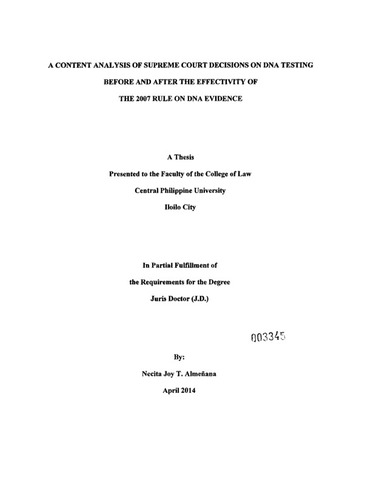| dc.description.abstract | DNA is a molecule that encodes the genetic information in all living microorganisms. A person’s DNA is the same in each cell and it does not change throughout a person’s lifetime. The DNA in a person’s blood is the same as the DNA found in his saliva, sweat, bone, the root and shaft of hair, earwax, mucus, urine, skin tissue, and vaginal and rectal cells. Most importantly, because of polymorphisms in human genetic structure, no two individuals have the same DNA, with the notable exception of identical twins.
DNA Testing is the most powerful tool for human identification. Since its discovery in the mid-1980s, DNA profiling had caused a paradigm shift in the identification of victims, perpetrators and witnesses in numerous cases. Recent advances in forensic DNA testing are now paving the way for reforming the manner by which cases are resolved in courts of law through the way suspected offenders are apprehended during a criminal investigation.
The Supreme Court has issued a Rule on DNA Evidence, which took effect on October 15, 2007. The Rule provided, among others, for the procedure in the application and order for DNA Testing, the Court’s assessment of the probative value of DNA evidence, the evaluation of DNA Testing results, and post-conviction DNA Testing. This study was conducted to determine the different cases decided by the Supreme Court before and after the effectivity of the 2007 Rules on DNA Evidence (A.M. No. 06-11-5-SC). This study aimed to examine the salient points of the Rule on DNA Evidence by discussing the manner of presenting DNA evidence, determining the steps in DNA analysis, identifying the types of DNA testing, classifying the uses of DNA testing, and assessing the probative value and weight of DNA evidence.
DNA analysis is used in the identification of dead bodies, studying the evolution of human populations, studying inherited disorders, identifying potential suspects whose DNA may match evidence left at crime scenes, exonerating persons wrongly accused of crimes, and establishment of paternity and other family relationships.
There are several technologies being used in DNA analysis and these are Autosomal DNA Analysis, which may use Restriction Fragment Length Polymorphism (RFLP), Polymerase Chain Reaction (PCR), or Short Tandem Repeat (STR) techniques, Mitochondrial DNA Analysis, and Sex Chromosomal Analysis, which employs Y Chromosomal Analysis or X Chromosomal Analysis.
This study employed twenty-five (25) cases decided by the Supreme Court, which involved DNA testing. The cases were arranged in chronological order. Sixteen (16) cases were decided before the effectivity of the Rule and nine (9) cases were decided after the effectivity of the Rule. Ten (10) cases involved paternity and filiation and fifteen (15) were criminal cases. Out of the sixteen (16) cases that were promulgated before the effectivity of the Rule on DNA Evidence, four (4) cases were subjected to DNA testing. Meanwhile, four (4) out of nine (8) cases promulgated after the effectivity of the Rule were subjected to DNA testing.
Although the Rule on DNA Evidence provided the guidelines in the collection, handling, and storage of DNA samples, DNA results were often challenged due to the chain of custody, qualifications of the expert, reliability of the technique for testing evidence, reliability of the analyst(s) performing work, reliability of the laboratory in which testing was performed, contamination of evidence and/or test results, mishandling of evidence, human error during testing, bias in testing, lack of information regarding when and how the DNA was deposited on an item, and lack of control over the handling of the evidence prior to receipt in the laboratory. | en_US |



